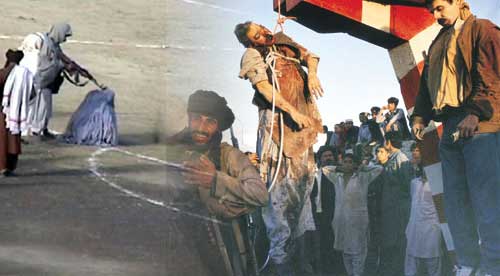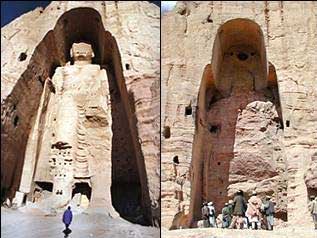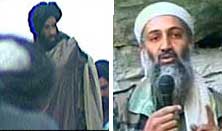The Taliban Connection
|
The Taliban - the infamous rogue government of Afghanistan that was noted for its intolerance, extremism and terrorist ties - was heavily aided, supported and in some ways created to the government in Pakistan. The History The Taliban's growing power in Kandahar attracted the attention of the Pakistani government, which hired the Taliban in November 1994 to protect convoys traveling between Pakistan and Central Asia. Taliban successes against local warlords attracted more followers and emboldened the Taliban to take control of Jalalabad, the eastern city bordering Pakistan on Sept. 11, 1996. Kabul, the capital of Afghanistan, was occupied by the Taliban on Sept. 27, 1996. The Taliban gained the support of both disaffected mujahedeen from the Soviet invasion of Afghanistan as well more recent graduates from the madrassas, Islamic schools often teaching extremist views. Ethnic allegiance also secured Taliban membership. Most of its members were Pashtun, the majority ethnic group that ruled Afghanistan for 2 1/2 centuries but lost power following the Soviet occupation. The Taliban's popularity and predominant military might gave it a tentative legitimacy to rule the country, and by June 1997 the militia controlled two-thirds of the country. Islamic Extremism
After seizing control, the Taliban instituted strict enforcement of Sharia, Islamic religious law. The enforced harsh and oppresive laws including:
Religious Intolerance
In addition the Taliban had no respect for other religious beliefs. Claiming that "Islam prohibits carving and worship of statues”, in 1998, the Taliban dynamited the giant (53 and 38 meter) Bamiyan Buddha Statues built in the 4th century AD. In addition the Taliban also destroyed a statue of an eagle that was built at a cost of $40 million Afghani in the 1970’s. The eagle was located in the spiritual center of Islaili sect in that province. The Taliban also forced Sikh and Hindu minorities to wear distinctive markings on their garments, a measure compared to Nazi treatment of the Jews. Among the signs proposed by the Taliban were yellow badges, as well as a tika, a small red mark on the forehead. The Taliban also required that yellow flags mark the houses of Hindus and Sikhs. It is only after the fall of the Taliban regime that these minorities are cautiously returning to their homes. The Birth of the Taliban As the Taliban came in to power, Pakistan saw that both governments shared similar interests. Pakistan noted Mullah Omar’s (leader of the Taliban) growing popularity and that he was viewed as a “Robin Hood” figure. It started to funnel military and economy support to his movement in order to reach its objectives in the region. As Western analysts note, Pakistan is “obsessed with defeating India” and was trying to create what it called “strategic Islamic depth” along its western border. With another Islamic fundamentalist state, Pakistan could draw more support and militant jehadis to fight in the Indian side of the disputed region of Kashmir. Pakistanis wanted to use Afghanistan as a kind of platform through which they could move commercially and perhaps politically into the Muslim, newly-independent states of the former Soviet Union. Therefore, Pakistan needed a friendly regime in Kabul. Because Mullah Omar did not have many fighters, Pakistan encouraged Afghan refugees who were students at Wahhabi Islamic schools in Pakistan to support him. This led to the creation of the Taliban (“students” in Arabic), a movement that was co-opted by the Pakistani military intelligence, or Inter-Services Intelligence (ISI). In the fall of 1996, the Taliban overthrew Afghanistan’s government. Meanwhile, Osama bin Laden had been expelled from Sudan. As he had connections with the ISI, Pakistan facilitated his move to Afghanistan. Pakistan sort of married Osama bin Laden and his al-Qaeda network to the Taliban.
Mullah Omar and his colleagues are not a highly sophisticated group of people nor highly literate. They practice a folk culture Islam which is not based in the philosophy and study of Islam; however, they believed they were good and devout Muslims. Therefore, the impressionable Taliban respected the knowledge and sophistication of al-Qaeda and became more radicalized by its involvement with the network. Al-Qaeda leaders became very influential as advisors to the Taliban. As for Pakistan’s interconnection with the Taliban, that country swelled the ranks of the Taliban by rotating some 60,000 Pakistani students into the Taliban forces. Relations after September 11th After September 11th, Pakistan was forced to choose between their Taliban-Al-Qaeda alliance and their alliance with the United States and other Western powers. As it is now known, Pakistan and General Musharraf carried out a balancing act that managed not to deeply upset the West or the Islamic Fundamentalists to a great extent. While claiming allegiance to the United States and enjoying praise, monetary and military support from Western powers, Pakistan covertly aided the Taliban simultaneously. Though not well known to the general public, the CIA and other intelligence agencies have acknowledged that Pakistan Infantry Regulars were fighting alongside the Taliban. However, as the fall of the Taliban became inevitable, Pakistan began to airlift their troops out of the country. However, by the end of the conflict Afghanistan’s new Interior Minister Yunus Qanooni said “There are over 5,000 Pakistan Army personnel and foreign mercenaries who are said to be still in Afghanistan. We have arrested foreigners in the country and action will be taken against them as foreign prisoners.” In addition it is widely believed that Osama Bin Laden, Mullah Omar and other Al-Qaeda and Taliban leaders have fled to Pakistan under the protection of the ISI, the Pakistani version of the CIA and tribals in Northwestern provinces. Conclusion In President Bush’s speech on September 11th he said that “We will make no distinction between the terrorists who committed these acts and those who harbor them.” Bush has taken action against the Taliban, who harbored terrorists. Yet he has turned a blind eye to the Taliban’s creator and another harborer of terrorists – Pakistan. Links:
|



